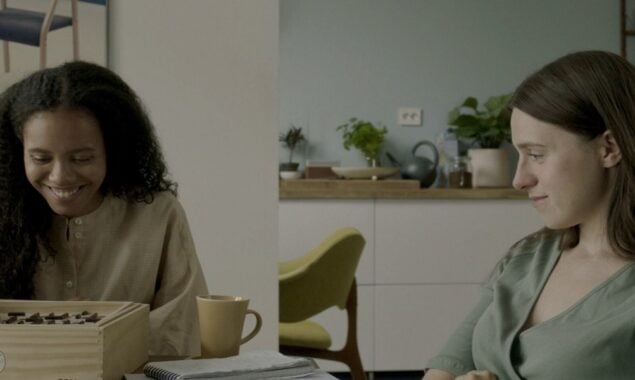
A Human Position
A quiet, deep character drama about a young Norwegian journalist dealing with trauma.
The second film from Anders Emblem is a quiet, sylph-like mood piece set in the wistful blues of long Nordic summer nights. It follows journalist Asta (Amalie Ibsen Jensen) as she pursues the story of an Afghan asylum seeker while also coming to grips with her own silent recent trauma. It appears to be a delicate wisp of a thing at first view, but the storytelling’s light touch does not diminish its impact. The film is, in its modest way, a deep and very wonderful portrayal of a life gradually mending, with its subtle visual rhythms and implanted meaning.
This film is set in the beautiful port town of Lesund on Norway’s west coast, which was also the setting for Emblem’s first film, Hurry Slowly, which won Best Narrative Feature at the Somerville International Film Festival. However, the film’s cinematic DNA can be traced back to the kind of low-key, intimate dramas that have long been a festival staple. The muted delights of A Human Position, which screens in Jeonju after its world debut in Rotterdam, are tailor-made for the kind of intelligent audience who appreciates slow cinema pace — an audience that is more likely to be discovered at film festivals than in theatres.
When we first meet Asta, she exudes inertia. Asta’s every movement is labored, the strain of carrying the weight of melancholy is at times too much for her. Her kitten happily potters around the room, while her girlfriend Live (Maria Agwumaro) hums to herself somewhere out of the frame.
She returns to her job at the local newspaper after taking a leave of absence, covering a provincial beat that includes the cruise ship business and protests against property developers who threaten the town’s unique Art Nouveau architecture. Back at home, furniture restorer Live works calmly on an impressive collection of mid-century Scandinavian chairs. It’s no coincidence that Live earns a profession by reassembling shattered, beautiful objects and giving them new life. Asta’s gaze is pulled repeatedly to a Stokke baby seat stacked among Live’s works in progress, the first hint as the root of her consuming grief. The interaction between them is understated, but there are observant, lived-in touches that give the relationship a convincing warmth. Live, who spends her days tenderly refinishing bent ply chairs, prefers to sit on the floor and out of view, her hand periodically popping in the frame to demand a bit of cheese and cajole Asta out of her somber introspection. The framing of the picture is exceptionally exquisite, favoring long static wide shots in which Asta’s tiny figure is usually the sole live person amid sweeping lonely streets.
The incident that pulls Asta out of her mourning is only obliquely mentioned in the film, rather than being extensively explored. She is moved by the narrative of an Afghan asylum seeker who is about to be deported. And, despite the fact that she never meets him, her inquiry into his circumstances casts a new light on her own situation. This isn’t a film that gives us a sense of closure; rather, it allows us to take a little journey with its protagonists on a voyage that, as the title suggests, is about to take a new turn.
For the latest Entertainment News Follow BOL News on Google News. Read more on Latest Entertainment News on oldsite.bolnews.com
Read More News On
Catch all the Entertainment News, Breaking News Event and Latest News Updates on The BOL News
Download The BOL News App to get the Daily News Update & Follow us on Google News.




